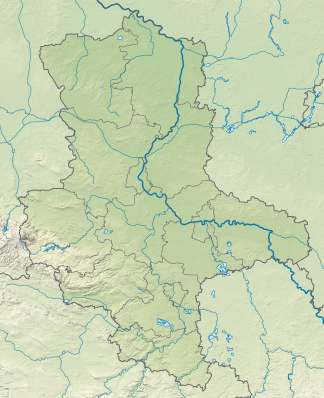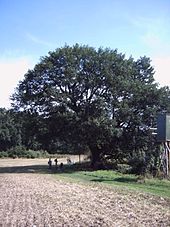Hellberge (Altmark)
| Hellberge (Zichtau Mountains, Altmark Switzerland) |
||
|---|---|---|
|
Hellberge from the direction of Landesstraße 26 ( Breitenfeld - Schwiesau ) |
||
| Highest peak | Langer Berg ( 159.9 m above sea level ) | |
| location | Altmarkkreis Salzwedel , Saxony-Anhalt ( Germany ) | |
|
|
||
| Coordinates | 52 ° 35 ' N , 11 ° 18' E | |
| rock | Terminal moraine of the Saale Ice Age | |
The Hellberge (also called Zichtauer Berge or Altmärkische Schweiz ) in the Saxon-Anhalt Altmarkkreis Salzwedel are one to 159.9 m above sea level. NHN high ridge of the Altmark .
The name Hell is derived from an original designation of the word oblique or pendent . The area is part of the natural spatial main unit group Wendland and Altmark .
Geographical location
The ridge extends in the western Altmark northwest of the town of Gardelegen between the villages of Breitenfeld , Estedt , Schwiesau , Wiepke and Zichtau . It is located west of the Gardelegen– Salzwedel section of the federal road 71 . The highest point of the Hellberge is the Lange Berg ( 159.9 m ). The other hills include the Stakenberg ( 148.3 m ) and the Mönchenberg ( 121.4 m ).
history

Emergence
The Hellberge originated in the Saale Ice Age around 120,000 years ago. Large glaciers pushed masses of debris up to this point and left a terminal moraine landscape. There are three layers of ice on the edge of the ice in the Hellberg Mountains. The meltwater from the glaciers created relatively deep valleys. This resulted in the height differences of about 130 meters between the east flowing Milde near Wiepke ( 30 m ) and the Langen Berg ( 159.9 m ), which are unusual for northern German conditions .
In the vicinity of Wiepke and Zichtau, the glaciers also pushed deeper layers of soil from the Tertiary to the surface, so that marl occurs there. In addition, can be found due to the glacial origin, many boulders of granite .
colonization
The first traces of human settlement can be found for the Stone Age . The Hellberge were forested at this time, with pedunculate oak and sand birch predominating on the hills, and red beech and hornbeam in the valleys .
Intensive overexploitation of the forest took place as early as the Middle Ages , so that the Hellberg Mountains were characterized by a steppe landscape in the 15th century . The dominant plants were various types of gorse , common heather , grasses, birches and individual beeches and oaks.
In 1817, the bailiff Johann Solbrig from Zichtau began to reforest the Hellberge, which is now wooded again. Pine trees dominate the hills, while ash , alder , oak and beech trees dominate the valleys .
In 1964 the Hellberge part of the conservation area, Zichtauer Mountains - Klötzer forest .
plants
Besides the above-named trees also come Ackerfilzkraut , Bracken , club moss , heather, Breitblättriger shopping , broom, ceratocapnos claviculata , Everlasting Flower and Polypody ago. The Hellberge are also known for their many mushrooms and blueberries .
Animals
In the field of Hellberge many rare partly species such as live wolf , woodpecker , green woodpecker , black woodpecker , stock dove , turtle dove , backed Shrike , Great Gray Shrike , nightjar , forest lizard , sand lizard , salamander , newt , newt , natterjack toad , European tree frog , moor frog , stag beetle and grasshopper .
Natural monuments
A total of 16 natural monuments are under special protection in the Hellberge, for example the Ferchel oak from Ferchel, which was abandoned in the 18th century . Another special feature is the source moor of the Wiepker Bach , the Elf Quellen . To the north of the village of Zichtau, there is the now dead Zichtau oak , which is said to be 1000 years old.
tourism
The area is made accessible for hikers and cyclists by paths. Equestrian tourism and Kremser rides are also offered. There are small hotels and pensions in the surrounding villages and towns.
Individual evidence
literature
- Bernd Wolterstorff: Zichtau mountains, nature and landscape in the Altmark district of Salzwedel. Leaflet


